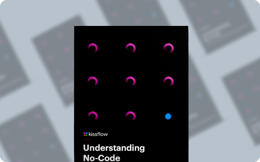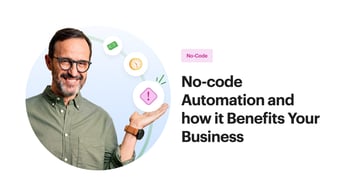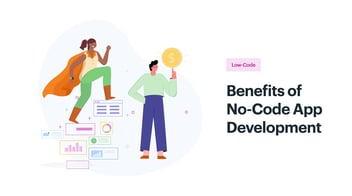Your process has problems. Your workflow are in knots, you can’t track anything, and everyone has someone else to blame for their troubles.
Normally, you might go to the IT team asking for something quick that would iron out all your problems. But a few months ago, IT did a special training on a new no-code platform they rolled out for everyone to create their own business process applications. It was done in beautifully, but the message was clear: we don’t have time to make these apps for you anymore, do it yourself.
So, you sit down and open up the platform. Your thoughts race back to being in high school and staring at your first spreadsheet, having no idea how to make this powerful tool work for you.
As you try to think through your process, you quickly start justifying how everything really isn’t so bad. You can deal with a little chaos. Everyone has to endure these things, right?
But soon enough you remember what drove you here and the problems you plan to eliminate.
Now, how do you start?
The Power of Building Applications on Your Own
You probably didn’t get into business to learn how to build an app, but with the rise of easy no-code development platforms, it will soon be as essential to every business leader as starting a spreadsheet or writing an email.
Most of the tools business leaders use are static–data just sits on them until you push it somewhere. But when you build business apps, you are creating something almost alive. It can perform functions even when you are not forcing it to and makes your work much more effective.
As we look at building applications for the non-programmer, we’ll focus specifically on automated business process applications or those that follow the typical pattern of taking a set of data through a predefined workflow.
Here are seven questions you can ask to get started and build your own process app:
1. What is the goal of automating this process?
Think about what drove you to pursue automating your process in the first place. What are the challenges you currently face? Do you have trouble tracking items going through the process? Do you need to increase the speed of processing? Are you trying to reduce errors? Has handling the process with email and spreadsheets reached its chaotic limit?
By identifying the primary reason for automating your business process app, you will know where to focus your efforts and make sure you walk away with an app that meets your needs. Otherwise, you may get distracted easily.
2. Where does the process start and end?
What is the signal that the process is going to start? Does it start with an idea or a need? Are you handed data from another department that needs to be processed? What data does the process start with?
How do you know when your work is finished? Does another process begin as soon as yours ends? When is it completely off your hands?
By identifying the start and end point, you can be more clear about addressing your major concerns and know exactly when the process is over.
3. Who needs to be involved in the process?
In any process, there are usually multiple people who must act. Each of these represents a different task in your workflow. Some may provide input, while others give approval.
But workflows of people are usually more complicated than a simple sequence. Some people may only need to be involved under certain conditions. Others really only need a notification that the process is on the move. Use a workflow modelling tool to create the ideal situation. You can also set deadlines and SLAs for each task depending on what needs to happen.
4. What information does each person need to know?
At each step in the workflow, the owner of that task needs to see certain data to process the request. Not having all the right data is one of the major reasons why processes break down and people start blaming each other.
For each step, figure out which data fields need to be shown. Configure these as you build your form. You should be able to set fields as hidden, read-only, or editable at each stage so that the right people see the right data.
5. Can you integrate this with other software to cut out human steps?
Once you’ve mapped out your workflow, the next thing to consider is if you have any tasks assigned to a human that might be better done by a machine. A lot of these tasks involve transferring data from one system to another. For example, if you are running a financial process, you may need data to flow in and out of your accounting software.
Using webhooks and other integrations, you can assign these tasks to a machine which will perform it faster and without any errors.
6. What would be amazing if it would work?
When building applications, you may not be aware of all things the platform can do. So, it’s best to dream big and see what can happen. Want the form to auto-populate data of the person filling it out? What about dynamically assigning a task to someone based on a field? How about linking a drop-down menu to a database?
There are more possibilities than you could guess out there, and platforms to build business apps are getting easier and more powerful all the time.
7. What metrics do you want to check on?
Finally, think about how you will prove that you’ve reached the goal you set out for creating your business process app. Can you track the speed at which things are processed? How do you measure errors? What about the ability to track?
Any good no-code platform for building business apps will have a great reporting feature which allows you to see how your process is performing. Choose the best metrics which show that you are truly turning the process around and not just digitizing it.
Try Kissflow for Building Business Process Apps
If you don’t currently have a no-code platform that is easy enough to use, even for a non-developer, then try Kissflow No-Code. It has all the features you need, but users mostly rave about how easy it is to use, no matter what your technical abilities are.
If you aren’t in IT, but are still wondering how to build an app, start with a no-code platform and design your first automated process. It’s much easier than you think and these questions can help set you off on the right foot!














